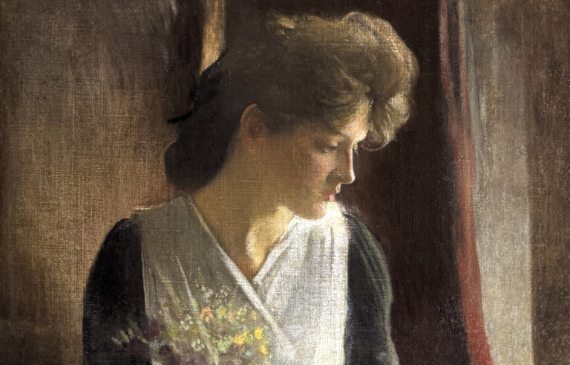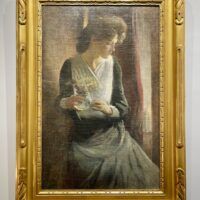

John White Alexander (American, 1856-1915)
Contemplation, circa 1900
Oil on canvas laid down on panel
39 H. x 25 W. inches
John White Alexander was a prominent and exceedingly famous artist in New York City in the late 19th century and early 20th century. The majority of his work is made up of portraits, murals, and figures, chiefly female figures. The style of Alexander is fluid and sweeping, with a decorative use of color. His early work began as realist but soon became more expressive, with an emphasis on mood and feeling.
Alexander was born in 1856 in Allegheny, Pennsylvania, now part of Pittsburgh. He was orphaned as a child and raised by his grandparents. At the age of 12 he dropped out of school and became a telegraph messenger and it was here where his talent for drawing was discovered by the secretary/treasurer of the telegraph company. This man, Colonel Edward Jay Allen, eventually took guardianship of Alexander and pushed him to return to high school.
When he was 18 he moved to New York where he began to work at “Harper’s Weekly”. He eventually got promoted to illustrator and political cartoonist. Some of the subjects he focused on were the 1877 Pittsburgh Strike and illustrations done from field work in New Orleans and Yellowstone.
After his work at “Harper’s Weekly”, he left for the Royal Academy in Munich, to obtain formal training. Due to a lack of funds, he left the Academy after a few years and studied with Frank Duveneck in Europe in the years 1879 to 1881. They traveled to Venice where he met James McNeill Whistler and was introduced to the Tonalist style of art.
In 1881 he returned to New York and continued to illustrate and paint portraits. From 1881 to 1889 he worked as an instructor of drawing at Princeton University. After his marriage in 1887 to his wife Elizabeth Alexander, they moved to Paris in 1890. Here he became a leader in the Art Nouveau movement. His subject matter was mostly female figures and portraits. After a successful exhibition in 1892 at the Paris Salon, Alexander was immediately elected in to the Societé National des Beaux Arts.
Alexander then had a slew of impressive commissions and art prizes. These include: the mural for the Library of Congress in Washington D.C. (1895), the Lippincott Prize at the Pennsylvania Academy of Fine Arts (1899), receiving the Gold Medal of Honor at the Paris Exposition Universelle (1900), getting recognized as the Chevalier of the Legion of Honor (1901), becoming a member of the National Academy of Design (1902) and later the president (1909-1915), receiving the Gold Medal at the World’s Fair in St. Louis (1904), and the Medal of the First Class at the Carnegie Institute International Exhibition (1911).
After an exceptional life and career, John White Alexander died at the age of 58 in New York in 1915.
His works can be found in the Metropolitan Museum of Art, the Brooklyn Art Museum, the Los Angeles County Museum of Art, the Museum of Fine Arts in Boston, the Butler Institute, the Library of Congress in Washington D.C., the Carnegie Institute in Pittsburgh, and more.